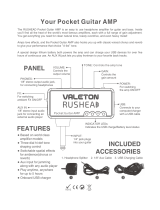
10
EFFECT
PREAMP
COSM technology simulates dierent preamp characteristics, speaker
sizes, and cabinet shapes.
Parameter Value Explanation
ON/OFF OFF, ON Turns this eect on/o.
TYPE Refer to PREAMP TYPE
GAIN 0–120 Adjusts the distortion of the amp.
LEVEL 0–100
Adjusts the volume of the entire
preamp.
* Be careful not to raise the Level
setting too high.
BASS 0–100
Adjusts the tone for the low
frequency range.
MIDDLE 0–100
Adjusts the tone for the middle
frequency range.
TREBLE 0–100
Adjusts the tone for the high
frequency range.
PRESENCE 0–100
Adjusts the tone for the ultra high
frequency range.
* The PRESENCE parameter functions
as a high-cut lter with some
PREAMP TYPEs.
BRIGHT OFF, ON
Turns the bright setting on/o.
* The BRIGHT parameter setting is
available only with certain PREAMP
TYPEs.
SP TYPE
Select the speaker type.
OFF This turns o the speaker simulator.
ORIGINAL
This is the built-in speaker of the amp
you selected with PREAMP TYPE.
1x8”
This is a compact open-back speaker
cabinet with one 8-inch speaker.
1x10”
This is a compact open-back speaker
cabinet with one 10-inch speaker.
1x12”
This is a compact open-back speaker
cabinet with one 12-inch speaker.
2x12”
This is a general open-back speaker
cabinet with two 12-inch speakers.
4x10”
This is an optimal speaker cabinet for
a large enclosed amp with four 10-
inch speakers.
4x12”
This is an optimal speaker cabinet for
a large enclosed amp with four 12-
inch speakers.
8x12”
This is a double stack of two cabinets,
each with four 12-inch speakers.
PREAMP TYPE list
Type Explanation
NATURAL CLEAN
An unembellished, clean sound that minimizes
the amp’s idiosyncrasies, such as its trebly
character and boomy low end.
FULL RANGE
An amp with a broad frequency range and
an extremely at response. Good for acoustic
guitar.
COMBO CRUNCH
Crunch sound that allows the nuances of your
picking to be expressed even more faithfully
than on conventional combo amps.
Type Explanation
STACK CRUNCH
Great-feeling crunch sound that responds well
to picking dynamics while retaining all the
dening characteristics of a 4 x 12” speaker
cabinet.
HIGAIN STACK
High-gain sound of a vintage Marshall specially
revamped in a way that is possible only with
COSM modeling technology.
POWER DRIVE
A straight drive sound that works well in a
broad range of situations, from backing to lead.
A sound like this cannot be obtained from any
existing combo amp or stack amp.
EXTREM LEAD
A new type of sound that smoothes out the
uneven frequency response that is typical of
existing large stack amps.
CORE METAL
A large stack sound that has been tweaked
extensively in the pursuit of the ultimate metal
sound.
JC-120 This models the sound of the Roland JC-120.
CLEAN TWIN This models a Fender Twin Reverb.
PRO CRUNCH This models a Fender Pro Reverb.
TWEED This models a Fender Bassman 4 x 10” Combo.
DELUXE CRUNCH This models a Fender Deluxe Reverb.
VO DRIVE
This models the drive sound of a VOX AC-30TB.
This is a sound that it suited to sixties-style
British rock.
VO LEAD
This models the lead sound of the VOX AC-
30TB.
MATCH DRIVE
This models the sound input to left input on a
Matchless D/C-30.
A simulation of the latest tube amp widely
used in styles from blues and rock.
BG LEAD
This models the lead sound of the MESA/
Boogie combo amp.
The sound of a tube amp typical of the late ‘70s
to ‘80s.
BG DRIVE
This models a MESA/Boogie with TREBLE SHIFT
SW on.
MS1959 I
This models the sound input to Input I on a
Marshall 1959.
This is a trebly sound suited to hard rock.
MS1959 I+II
The sound of connecting inputs I and II of the
guitar amp in parallel, creating a sound with a
stronger low end than I.
R-FIER VINTAGE
Models the sound of the Channel 2 VINTAGE
Mode on the MESA/Boogie DUAL Rectier.
R-FIER MODERN
Models the sound of the Channel 2 MODERN
Mode on the MESA/Boogie DUAL Rectier.
T-AMP LEAD This models a Hughes & Kettner Triamp AMP3.
SLDN
This models a Soldano SLO-100. This is the
typical sound of the eighties.
5150 DRIVE
This models the lead channel of a Peavey EVH
5150.
BGNR UB METAL
This is a heavy distortion sound that models
the high-gain channel of a Bogner Uberschall.
ORNG ROCK
REVERB
This models the dirty channel of an ORANGE
ROCKERVERB.



















